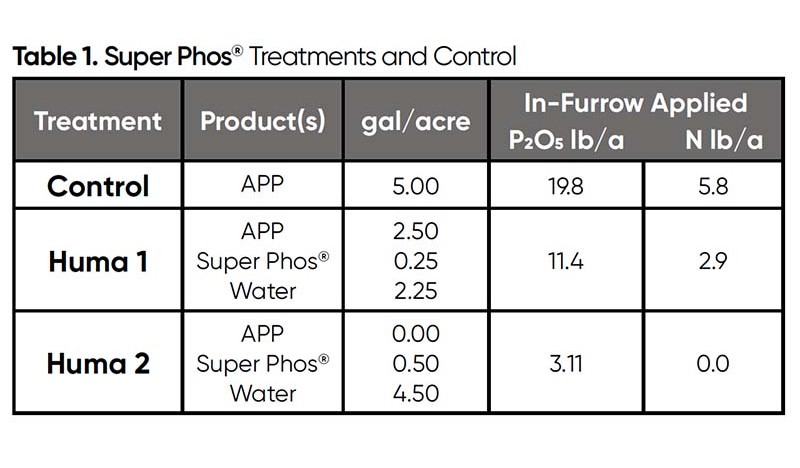Background
Application of phosphorus (P) fertilizers—such as triple super phosphate (TSP), monoammonium phosphate (MAP), diammonium phosphate (DAP), liquid ammonium polyphosphate (APP), and other forms—can be inefficient and, at times, not environmentally friendly. A technology that can mitigate these P fertilizer challenges without compromising yield and return on investment is highly desirable. Huma® Super Phos® is an ultra-efficient liquid P (0-50-0) fertilizer with proprietary Micro Carbon Technology®(MCT). MCT is proven to enhance the uptake of nutrients by plants, allowing farmers to grow more with less.
Super Phos® has previously been tested on various crops in many locations around the world under diverse growing conditions using foliar- and/or soil-applied. The common approach included either partially or completely replacing conventional P in single or split-application scenarios.
Objective
The objective of this trial was to determine if the efficiency of soil-applied Super Phos® found in the previous trials could be replicated in a multi-state field study at corn planting.
Materials & Methods
In this study conducted at 5 locations in 4 states across the U.S. Midwest (the Corn Belt), over 200 acres, Super Phos® efficiency was tested on corn fields against a commonly used P fertilizer. Standard application of liquid APP alone was compared with two treatments, Huma 1 and Huma 2. The phosphorus fertilizers were applied in-furrow at planting (see Table 1). Treatment parameters were as follows:
- Control—APP was applied at 5 gal/acre.
- Huma 1—The APP rate was reduced to half (2.5 gal/acre) and Super Phos® was added at one-tenth (0.25 gal/acre) the APP rate with no additional nitrogen.
- Huma 2—No APP and no additional nitrogen were applied at planting. Super Phos® was applied alone at one-tenth (0.5 gal/acre) the rate of APP (5 gal/acre) used in the Control.

Results
Despite the scale of this field study under different growing settings and various weather conditions, the corn yields were similar to regional averages under all treatments (see Figure 1).

Figure 1. Average Corn Yield Across All Locations, by Treatment
* Yield results with the same letter (a) are not significantly different from each other.
When 42% less P2O5 and 50% less N were applied to the corn at planting under the Huma 1 treatment, the yield was essentially the same. Then, under the Huma 2 treatment, when APP was completely replaced with Super Phos® (0-50-0) at planting at one-tenth the rate of APP, which delivered much less (84% less) P2O5 than the APP source with no nitrogen in it, the average yield was slightly higher (1.9 bu/acre) which resulted in $10.50 per acre net income gain. In addition, if the shipping cost savings of Super Phos® over APP are taken into consideration, the net income gain advantage for a farmer grows by about twofold ($23.51/acre).
Conclusions
Using Super Phos® to decrease the amount of P2O5 and N fertilizer input resulted in a slight corn yield increase in this multi-state field study and generated a cost savings. In addition, 42%–84% less P2O5 and 50%–100% less N input at planting might contribute to less N leaching into groundwater and less P runoffs and surface water pollution, especially if such practice is implemented on a broader scale. Super Phos® offers sustainable benefits for both growers and the environment.

